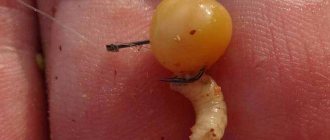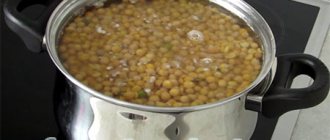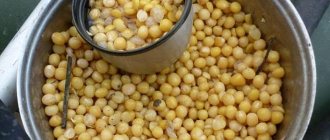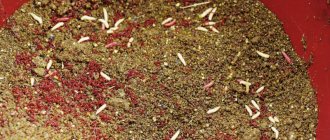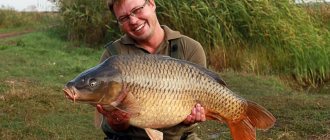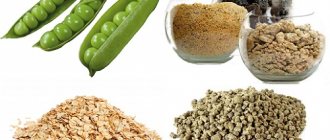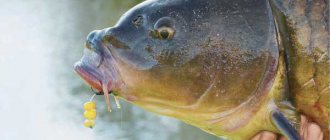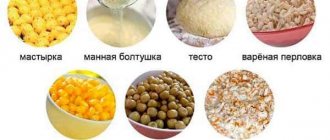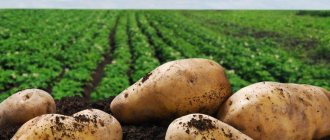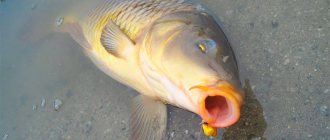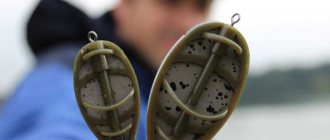Steamed pea grains can be considered a traditional bait for carp fishing.
Freshly prepared bait has a persistent, pleasant smell, and if you don’t boil the peas “into porridge” but make them soft and plastic, then you can’t think of a better bait and most carp will prefer it to other food.
The undoubted advantage of peas is its size. Small fish are simply not capable of swallowing a round pea, so during the bite, mostly individuals weighing at least 300-500 grams are caught.
However, not all varieties of peas are suitable for preparing high-quality bait and groundbait that is guaranteed to attract carp.
Pea selection
The properties of pea bait are determined by its type and variety.
If you can use regular store-bought cereal to prepare regular bait, additionally adding various flavorings that attract fish, then for the bait that is needed to successfully catch carp, it is better to find freshly harvested peas.
Some fishermen specifically buy green peas, dry them themselves and use them for fishing during the season.
Properly prepared peas for hooking are deformed when squeezed between your fingers, but not destroyed.
When choosing unshelled peas, their skins should be wrinkled. This feature ensures that the skin does not burst during soaking and cooking.
Since peas can be used not only as bait, but are also widely used as bait and bait, about 30-40 kilograms of this grain will be needed for the carp fishing season.
Of course, running to the grocery supermarket before every fishing trip is stupid. Therefore, it is better to stock up on the required amount of dry seeds in advance by purchasing it from farmers or at agricultural food fairs.
Rules for preparing peas for fishing
The process of preparing peas may be called uncomplicated by some, but everyone will agree that without clear rules, peas may be cooked incorrectly, and your fishing will be ineffective. Pea selection
You should know that there are two types of peas - shelled and whole.
- Split peas are mostly sold in grocery stores in bags or bags. Peas are peeled and usually divided into two halves. This type of pea can be stored for a large amount of time without much loss of properties. When fishing, such peas are best suited for bait, but if you wish, you can equip a hook with such peas.
- Whole peas – has a natural structure without changes. These peas are ideal for fishing. It is worth remembering that there are several types of whole peas:
- Canned and young peas are used immediately; there is no need to cook them.
- Dried peas – require cooking as they have a hard structure.
Soaking peas
Proper soaking of the dry pea mixture determines not only the taste of bait and groundbait, but also the length of time the bait remains on the hook.
When soaked, the grains increase in size, and with further cooking, they will soften more evenly.
The most common methods for anglers to soak a dry product are:
In cold water
Can be produced for any variety, regardless of whether groundbait or bait, bait or bait is being prepared. The ideal option for carp fishing is to use soft, filtered water.
Some anglers soften water hardness by adding a teaspoon of soda per liter of liquid. However, at the same time, some varieties of peas darken and acquire a specific, “soda” smell.
Peas are soaked in the following sequence:
- The cereal scattered on the countertop is sorted, removing crushed and obviously damaged seeds.
- 1 part of the seeds is poured with 3...4 parts of cold water.
- Floating debris is removed from the surface of the water with a spoon.
- The seeds are kept for 6.0...8.0 hours.
Steaming pea grains with boiling water
It is used when the bait-nozzle needs to be prepared “in a hurry”:
- 1 part of the sorted seeds is poured with 3...4 parts of boiling water.
- Peas swelling time is about 2 hours
- After swelling , the water is drained, and the swollen peas are subjected to further processing if necessary.
How carp behave in October
In October, the carp bite is not constant, from morning to noon, mainly small carp will be caught. Trophy-sized individuals feed in mid-October more often in the afternoon, and then only in warm weather. At night in October, carp practically do not bite.
Carp shows a special interest in food during this period. The fish will feed on rainy and cloudy days, in calm weather, the main thing is that the air temperature does not fall below +7 degrees. When there is a strong wind, especially from the north, the activity of the carp sharply decreases; it stops feeding and rolls into deep holes, where it will wait out the bad weather.
The best time is the beginning of October. This is due to the fact that the weather outside is still good, but the food supply in the water area is decreasing. That is, underwater vegetation dies off, insects and larvae stop falling into the water. Thanks to this, the fish begin to show interest in the baits used by fishermen.
The worse the weather and the colder the water in the reservoir, the worse the carp will bite. In most regions, already at the end of October at the beginning of November, the activity of carp is approaching “zero”, it moves less around the reservoir, most of the time it is in the wintering hole. Fishing in such conditions is difficult; you can count on catching carp only if you manage to not only find the hole in which the carp is standing, but manage to throw the bait, which is said under the fish’s nose.
Steaming pea grains
Almost every carp fishing enthusiast has his own little tricks for preparing bait.
Various steaming methods have their own advantages and disadvantages, but they are all based on the following methods:
- Method 1. It is considered the most common and does not require any tricks:
- In a clean cotton bag (you can use a regular sock), you need to pour the required amount of soaked grains.
- The bag is placed in a pan with a wire rack on the bottom and filled with water - the bag should not swing against the walls of the pan.
- Cooking time – 15.0…20.0 minutes.
- The degree of readiness is determined by the integrity of the peel and sufficient plasticity of the grains - the pea should be compressed, but the integrity of the shell should not be compromised.
- Once ready, the grains are laid out on dry cotton cloth and dried.
- The finished nozzle is placed in a special container.
- To flavor the bait, add a few drops of anise or dill oil, or a special flavoring for carp, to the finished mass.
- Method 2. Differs from the previous one by placing the soaked peas in a saucepan filled with water and closed with a lid, which is placed in a water bath. The water in the saucepan is brought to a boil. Cooking time is about 20.0 minutes. Checking the readiness of the nozzle is carried out by analogy with the previous recipe.
- Method 3. Used when it is necessary to speed up the process of steaming grains. The peas are placed in a bag and cooked in a pressure cooker. At the same time, you should ensure that the bag does not touch the walls and does not float up. To do this, the water is brought to a boil over low heat, and the bag of peas is pressed against a grate installed at the bottom using some kind of weight. Ready time – 5.0…10.0 minutes after water boils.
- Method 4 involves using canned peas for bait and does not require any additional processing. The only thing you need to do before choosing a specific type of canned food is to choose a manufacturer who cans peas in a shell, and during canning they do not fall apart. To do this, you should purchase several cans of canned food from various brands, use the product suitable for fishing for its intended purpose - for fishing, and the remaining products will be useful for preparing Olivier.
Special baits for carp
Boyle
Today there are two types of special carp baits on sale. These are boilies and pellets (granules). Boilies are balls with a diameter of 5-30 mm, consisting of a mixture of various components that attract fish, flavorings and adhesives, and have also undergone special heat treatment.
Such baits can be attached directly to the hook, but most often they are attached to a “hair” in a special hair rig. It involves placing the boilie in close proximity to the hook, in such a way that the carp swallows the bait, which is safe for itself, and the bare hook, following it, enters the fish’s mouth unnoticed.
The composition of boilies must include flour (corn, soy or semolina), which is the basis of the mixture. Ground cereals, eggs or egg powder, bone or fish meal, starch, casein, gelatin, as well as various natural or synthetic attractants (flavors) are added to it.
The international classification of boilies classifies them according to their composition:
- meat containing bone or blood meal;
- fish - with the addition of fish meal or crustacean meal;
- spicy – containing garlic, onion, cumin, vanilla, etc.;
- fruit - with the addition of pulp of apples, plums, bananas, strawberries, pears, etc.;
- sweet – containing caramel, sugar;
The components are mixed in the required proportions and boiled in water or dried until a hard upper crust is formed, which does not allow the bait to become soggy in the water. Depending on the heat treatment process, boilies are divided into several types:
- floating - with a density less than that of water, which allows them to float;
- neutral buoyancy - with a density close to the density of water, allowing it to stay in the flow;
- sinking - with a density greater than water, which makes them sinkable;
The first type of boilies is designed for surface fishing. Such baits undergo minimal heat treatment, and a surface crust is formed during the drying process. Neutral boilies are used for fishing in deep water. The formed balls are boiled to a certain extent, allowing the bait not to encumber or lighten the tackle. Sinking boilies are used for bottom fishing. They go through a long cooking process until the mixture becomes heavy and a thick crust forms on the surface. The finished balls are painted a certain color.
Dusting boilies
There are also special dusting boilies designed for baiting fish. They quickly dissolve in water, forming an alluring “cloud” of mixture particles.
In markets and fishing stores you can buy boilies of various types, sizes and purposes. The most popular baits among carp anglers are the following manufacturers:
- Richworth;
- TandemBaits;
- DynamiteBaits;
- Zoom;
"Skopex"
Among the flavorings used in the manufacture of boilies, the ones that have proven themselves to be the best for carp fishing are:
- strawberry;
- plum;
- "skopex";
- a pineapple;
- "octopus";
When going for carp in a pond where they are constantly caught, it is better to ask the fishermen about their preferred bait. This will eliminate unnecessary costs for various types of bait.
When independently selecting and preparing various baits, keep in mind that:
- a maggot that is stored in a warm place becomes a pupa after 2 days;
- when buying canned products for bait, as well as ready-made boilies, it is better to give preference to well-known manufacturers;
- boiled corn, peas, potatoes should be stored only in the refrigerator and for no more than 2 days - a fermented product will certainly repel carp;
- when cooking boilies of your own making, they must be immersed exclusively in boiling water, otherwise they will simply dissolve in the water;
Make it a rule, on every fishing trip, the first thing you do is...
Drying bait and bait
After the grains have been steamed until cooked, they need to be dried. To dry, spread the peas in a thin layer on the balcony or in the kitchen (a draft speeds up the drying process) and wait for the excess moisture to evaporate.
Drying allows you to level out the defects of an overcooked nozzle, when its peel bursts even with gentle pressure.
If you increase the drying time, the grains will gain greater strength without losing their plasticity.
The dried bait is poured into a box or container with which you usually go fishing.
How to put peas on a hook
Many novice carp fishermen do not know how to properly attach peas to a hook. The website ryba4ok.ru will show several good methods and give recommendations for planting. Let's first look at several ways to attach directly to the hook tip.
1 way. Each pea has a white spot next to a black dot. This white spot is where the sprout would emerge from if you planted the pea in the ground instead of boiling it. The hook should be threaded through this white spot. You need to start from the top of the grain, move almost from the black dot under the white spot and bring the sting out approximately in the middle of the pea. Thus, it turns out that the tip of the hook passes between its two halves.
The tip of the hook must be brought out and remains open. Don’t let this bother you, it won’t affect the number of carp bites, but when biting the fish will definitely catch on the hook. If you hide the point of the hook inside the pea, then a lot of idle bites will happen.
Method 2. This method involves piercing the pea transversely, as if fastening its two halves with a hook. The hook tip is also brought out and remains open. The advantage of this method of baiting is that the two halves of the bait are secured to each other and will not fly off even with a powerful and long-range cast of the feeder.
But this method also has disadvantages. For example, when baiting using the first method, when a carp bites or hooks, the halves of the peas easily fall apart, releasing the hook. This way the hook is freed from the bait and it does not interfere with the reliable detection of fish. Whereas if you plant peas crosswise, the halves will not fall apart and the bait can be placed under full-fledged attack. But, nevertheless, this method is also popular with some fishermen.
3 way. It is optimal to catch carp using peas using a hair rig. This is the most effective equipment that has no disadvantages. The peas do not cling to the hook, but are attached to it through a hair. This way the hook remains free of bait and nothing prevents it from reliably hooking the carp by the lip.
In addition, the hook seems to be lying away from the bait and the carp is trying to suck in only the peas, but the hook is sucked in near the peas and the fish has practically no chance of getting rid of it. Most often, a carp bite on a hair rig ends with self-hooking. The fisherman just has to pull the fish onto land.
4 way. If using hair equipment is not possible, you can use its simple analogue. To do this, just thread the pea with an awl, pull a thread through this hole and simply tie it on the pea. You simply hook the hook onto this thread. Corn can be planted in the same way.
Equipment for carp fishing
To catch carp, where pea grain is used as bait, you can use a regular float rod, and for long casting, most fishermen use a reel rod or donka.
Considering the likelihood that large fish can bite, and the carp itself has sufficient strength, high-strength transparent fishing line is used to equip the fishing rod.
Hooks should be selected from numbers 5 to 8.
Particularly effective when using a donkey is a piece of gear called a “spring” in fishing slang.
It is a conical or cylindrical spring with dense coils, weighted with a sinker, inside which a pea bait is placed and from which leashes with hooks set with peas extend.
Bottom fishing rods are equipped with a single-core fishing line with a diameter of 0.25...0.3 millimeters. For long-distance casting, monofilament with a diameter of at least 0.4 millimeters or a braided cord is used as a shock leader. The length of the shock leader is usually 6.0...7.0 meters.
If fishing is carried out using a reel fishing rod, then a cheap but durable spinning rod from China is quite suitable. When choosing a reel, preference should be given to models with a rear clutch.
If you use a float rod to catch carp, it is better to equip the fishing line with 2 leashes with hooks. Since carp is a rather shy fish, it is advisable to opt for the longest possible rods.
How to cook?
Experienced fishermen are well aware of the various methods of preparing store-bought dry peas for carp fishing. It is boiled, steamed in a thermos, and used as the main ingredient for preparing crumbly porridge, which is an excellent carp bait.
Regardless of how you plan to cook the peas, they must first be soaked in warm water for several hours. Soak the peas so that later they are boiled or steamed evenly. Without pre-soaking, the peas will remain hard inside after boiling or soaking, which will exclude the possibility of using them as bait or bait.
The duration of soaking of peas from the latest crop is usually several hours. Peas from an earlier harvest are soaked for 10-12 hours or longer.
Boiled
To cook peas (regular or chickpeas), use the water in which they were soaked. Cooking is carried out first at maximum heat, and after boiling water - at moderate heat.
The duration of cooking depends on the size of the peas, their hardness and variety. Typically, relatively fresh peas (latest harvest) will take 30 to 50 minutes to cook. In order to boil old peas obtained from earlier harvests, it can take up to 1.5-2 hours.
It is extremely important not to overcook the peas, otherwise it will be impossible to attach them to the hook. To prevent overcooking, check the contents of the pan every 5-7 minutes during cooking.
Properly prepared peas, suitable for carp fishing, have sufficient density, do not fall apart when squeezed with your fingers, but turn into a uniform thick mass. Undercooked peas, when squeezed, fall apart into two solid halves; overcooked peas turn into a very soft, shapeless substance.
There is no need to salt the peas during cooking. However, some fishermen use sugar to enhance the taste of the future bait. It is added during cooking at the rate of 30 grams per 1 cup of peas. In cases where dry peas need to be boiled for a very limited time, very little soda is added to the water.
If the peas have softened and lost the required density and shape, they can be used to make pea dough and/or pea cakes. They have an appetizing smell that attracts carp, and can be used both as complementary food and as bait.
To prepare the dough, add boiled oatmeal to the pea porridge (at the rate of 0.5 cups of flakes per 1 cup of porridge). The resulting mass is thoroughly kneaded, adding wheat flour to it in small portions.
When the dough becomes dense and homogeneous, roll it into a thin flat cake, which is fried in vegetable oil on both sides. After waiting for the cake to cool, break it into pieces and knead it with your hands. Then the mashed pieces are again formed into a flat cake, which is again fried in oil. Such manipulations should be performed 3-4 times until the cake acquires sufficient density. Later, during carp fishing, small pieces are torn off from the cake and placed on the hook.
To prepare porridge, during the process of cooking peas, millet is poured into the pan, based on the proportions of 1: 1 (1 part of each ingredient). Additionally, a small amount of vegetable oil is added to the porridge. Cooking is continued until the porridge becomes thick and relatively homogeneous.
Steamed
For steaming in a thermos, only peas from the latest (fresh) harvest are used, which, after heat treatment, acquire the desired softness without losing their shape. It is poured into a thermos and filled with boiling water, after which it is infused for 10-15 hours. Old peas are not used for steaming, because even after a long stay in water they still remain hard.
It should be noted that many fishermen use various additives when steaming peas. Most often, they add additional ingredients to the thermos, such as:
- soda - accelerates the process of softening peas;
- sunflower oil or anise drops – give the bait an attractive aroma.
Other popular ingredients used when steaming peas are hemp oil (its aroma is very popular with members of the carp family), honey, vanillin, halva, and crushed cookies.
Mounting methods
Depending on how much the peas are steamed, you can use the following planting methods:
- on the hook .
- If the pea is hard , then the hook tip can be pulled out.
- If the bait is soft , the hook remains inside, the code is peeled.
- When the peel cracks and the pea splits into 2 halves, you can use the hook tip to connect them into a single whole.
- When fishing with a hair rig , the peas are pierced through and strung on it in the form of beads, which additionally attracts fish.
How to ripen peas?
Fishermen use the following two methods to mate peas:
- in a saucepan;
- in a pressure cooker.
In a saucepan
Cooking peas in a saucepan involves the following procedure:
- rinse the peas under running water and rid them of debris;
- add water and bring to a boil;
- cook over low heat for about forty or fifty minutes, depending on the “age” of the product used. The softness of the peas indicates that they are ready.
In a frying pan
Cooking in a pressure cooker allows you to speed up the cooking time for peas. If the pressure cooker works well, then the peas can be steamed in it in twenty minutes, which significantly saves the fisherman’s time.
An important nuance of cooking peas in a pressure cooker is that they cannot be poured all the way into the device.
Choosing a fishing spot
Before you try your hand at catching carp with peas, the fisherman must remember that for successful fishing the place must be “fed.”
This is quite simple to do - a few days before the planned fishing, in the place of the reservoir where the carp is found, bait should be scattered. The easiest way to do this is by throwing clay balls with pea fertilizer.
It is advisable to select a section of the reservoir with a hard, silted-free bottom.
During the fishing itself, the chosen place for carp fishing, where the hook with the nozzle is thrown, must be constantly fed. That is why most amateurs prefer the “spring” to all other gear.
Features of catching and feeding carp with peas
The fish will bite well only if it has previously been “accustomed” to peas, so it is very advisable to feed the bait over a couple of days. You can use your own prepared peas or a store-bought mixture with its addition. For feeding in areas significantly removed from the shore, special feeders will be needed.
While fishing, carefully monitor the float and try to hook more often, especially when the peas used are soft. If the carp constantly removes the bait, you should look for harder peas.
Author of the article: Vitaly Leonidovich Ivanov, 2021.
conclusions
As can be seen from the above brief overview, using a pea bait when fishing for carp has many advantages, and the main ones are:
- Availability and low cost of starting material for preparing bait and groundbait.
- Having been fed and having “tasted” peas , the carp prefers them to all other types of bait.
- This method of fishing for carp does not require the purchase of special equipment - the equipment used for catching crucian carp or bream is quite suitable.
- Peas can be used to catch carp at any time of the fishing season.
- Both homemade bait and the use of canned peas are suitable for fishing
How to catch carp with peas
Carp fishing for peas is not much different from fishing for other types of bait. It is necessary to determine a promising place where there is a high probability of catching fish. Then gear is collected, taking into account the characteristics of the reservoir and fishing conditions. All that remains is to prepare the bait and bait.
Place and time
The best time for catching carp with peas is summer, when the fish prefers bait of plant origin. A stable bite on this bait begins at the end of May from the moment warm weather sets in and continues until the first half of September. Then the underwater inhabitants change their diet, forcing fishermen to switch to animal bait.
It is better to catch carp using peas in shallow water areas with a muddy bottom and the presence of aquatic vegetation. It’s good if you can find a local bump or pit, a snag or an island of algae. Signs of the presence of fish: splashes, cloudy water, air bubbles - an additional plus of choosing a specific place for fishing.
Recommended reading: How to plant bloodworms
Fishing gear
There are no trifles in carp hunting. This is a large and strong fish. Once hooked, it can cause serious trouble for the fisherman, easily crushing flimsy gear. Therefore, assembling the kit should not be approached lightly, otherwise it will affect the fishing results.
You can catch carp with peas using different gear. Basic:
- feeder;
- float rod;
- plug fishing rod;
- match;
- Donka.
When fishing for carp with a fishing rod, you need to be prepared for a bite from a heavy specimen. Therefore, the gear must be reliable and powerful, capable of withstanding the pressure of strong fish.
As a reliable fishing line for carp fishing, monofilament and braided cord are used, with a breaking load of at least 5 kg. Monofilament better absorbs fish jerks and is almost invisible in the water. The braid is stronger with the same diameter, providing the gear with maximum sensitivity.
When choosing a spinning reel, you need to pay attention to its size and thrust. For carp fishing, it is advisable to take the 4000–7000 model with a gear ratio of about 3.8:1. What is important is the sensitivity of the adjustment of the friction mechanism and its trouble-free operation during sudden jerks of the fish.
How to put peas on a hook
There are two main ways to attach bait - directly on the hook and by hair mounting. The first is used mainly by beginners, the second by professional fishermen. Both are effective as long as the bait is placed correctly and securely.
Hook mounting:
- You need to find a sprout from a pea that is slightly different in color from the rest of the body of the nozzle. This way you can plant canned, boiled and young green peas.
- The puncture is performed in the area of the sprout.
- The hook tip does not come out, but it should appear from the bait.
When catching large carp, it is advisable to hook several peas onto a single bait or use a hair rig, in which the bait can be combined with foam balls, increasing its buoyancy, with boilies or corn grains.
Using peas as bait
Some anglers constantly add peas to their bait. Moreover, it can be used both independently and as part of multicomponent mixtures. In the first case, it is mixed with soil and slightly moistened with water to make it convenient to form feeding balls.
When attaching fish with peas, you need to monitor the amount supplied to the fishing area. This high-calorie product will quickly satiate the carp, and it will refuse to take the offered bait. Therefore, it is necessary to feed the point in small portions with an interval of 30–40 minutes.
